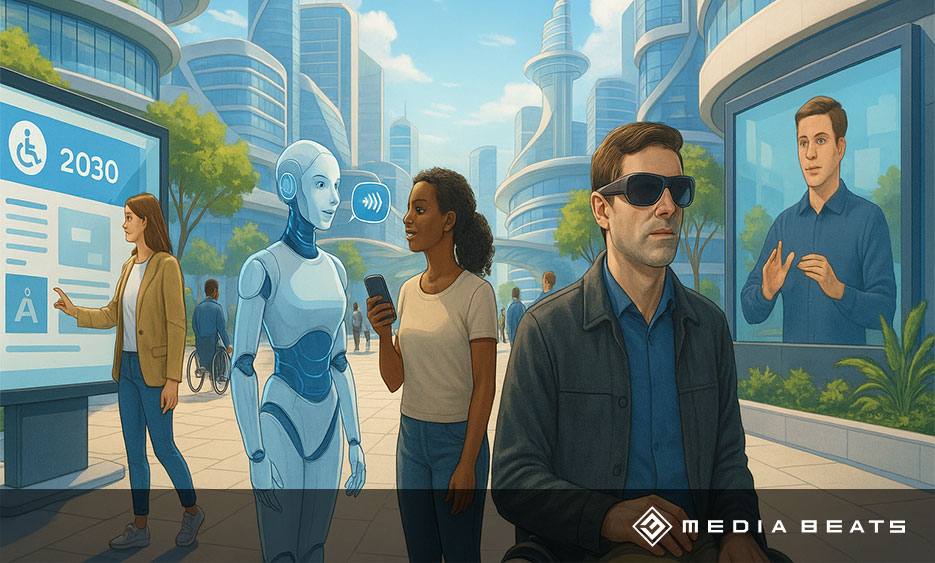
Accessibility 2030: What the future holds for digital accessibility
The world is rapidly shifting toward digital, making inclusive participation increasingly important. Regardless of physical limitations, as many users as possible should be able to access and actively engage with digital offerings equally. While legal requirements for accessibility continue to rise, technological advancement is also progressing steadily. Innovations and technical progress are constantly opening up new possibilities to make digital content more comprehensive and accessible.
In this article, we take a look at the future of digital accessibility and explain how new technologies and evolving legal regulations could shape the digital landscape by 2030.
AI in the future of accessibility
Artificial Intelligence (AI) already has a significant impact on the digital world today, and its application promotes an inclusive future. AI-powered tools that, for example, automatically generate image descriptions or convert text to speech support people with disabilities. This allows users to access digital content more easily and better meet their individual needs.
A particularly promising example is the use of machine learning to improve the user experience for visually impaired or blind individuals. AI systems analyze websites or apps and automatically make adjustments for screen readers and other assistive technologies. In addition, speech recognition opens up new perspectives, as real-time transcription technologies are increasingly improving the translation of sign language.
However, we are only at the beginning here, as many developments are still in the early stages. In the future, these technologies could be integrated on almost every platform, making digital content even more universally accessible.
Accessible web development: the standard of tomorrow
Today, many companies still view accessible web design as a voluntary measure, but that is about to change. The European Union has already established a clear legal framework with the Web Accessibility Directive. It obliges companies to consistently design their websites and apps to be accessible and to improve digital inclusion. However, the journey is not over, as by 2030, accessibility may become an essential standard for digital products.
Web developers are increasingly gaining access to tools that efficiently support and guide them in creating accessible designs. With the advancement of code frameworks and design guidelines, implementing accessible websites is becoming significantly easier. These developments help create solutions that are both functional and visually appealing while considering all users. Technologies such as “responsive design” and “adaptive layouts” automatically adjust to different screen sizes and user preferences. In the future, they will become even more central to reaching a broader target audience.
Inclusion through augmented reality (AR) and virtual reality (VR)
Augmented Reality (AR) and Virtual Reality (VR) could fundamentally revolutionize the way we perceive digital content. These technologies may open up entirely new possibilities for people with various impairments, such as those who are deaf or hard of hearing. AR and VR technologies could not only enable interactive experiences in the future but also make a significant contribution to accessibility.
Imagine a user with visual impairment receiving real-time visual information through AR applications. This information can be projected directly onto their smartphone or an AR headset to detect obstacles in the environment. It can also display contextual information to help with orientation. For people who are hard of hearing, VR technology could also open new ways to interact with others. Virtual sign language interpreters or immersive experiences could significantly simplify communication in virtual environments.
Possible legal changes in the coming years
Digital transformation not only increases the importance of accessibility but also introduces new legal requirements. While the Accessibility Strengthening Act (BFSG) in Germany has already made progress, regulations continue to evolve. It is expected that legislation will be adapted to meet future demands and ensure comprehensive accessibility.
A possible scenario by 2030 could involve making accessibility mandatory for all digital interactions. This would not only affect websites and apps but also include e-commerce platforms, social media, and various cloud services. Such legal changes could require companies to design and further develop accessible user interfaces (UIs). These UIs would need to consistently integrate both visual and non-visual communication methods.
The challenge of digitalization in an international context
As digital accessibility gains increasing importance worldwide, companies are facing new regulatory challenges in a globalized world. Countries like Canada and Australia have already introduced legal requirements that make digital accessibility mandatory. In other regions such as Asia and Africa, however, many companies are still confronted with significant challenges.
In the long term, this could lead to a global standard in which digital accessibility is anchored as a fundamental principle. International cooperation and the development of best practices are therefore becoming increasingly important for many companies. Companies must not only meet local requirements, but also successfully serve the growing global market.
Conclusion: Shaping the future of accessibility
Developments in digital accessibility are still in their early stages, but emerging technologies offer enormous opportunities. Technologies like AI, AR, and VR have the potential to take digital accessibility to an entirely new level. At the same time, they help to sustainably bridge the existing digital divide between different user groups. Legal regulations are also evolving, pushing companies to firmly integrate accessibility into their offerings.
The question is no longer whether companies need to address accessibility, but when they will do so. The digital transformation is already underway, and we all share the responsibility to shape it in a more inclusive and accessible way. The course is set for an accessible future, and we actively and passionately support this transformation.
Would you like to ensure that your website or app meets all digital accessibility requirements? Feel free to contact us today to learn more about our solutions in online marketing and performance marketing. Together, we’ll make your digital offering future-proof, accessible, and inclusive for all users!
